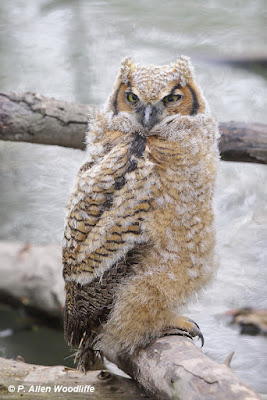As has been the case the last few years, the resident pair of Great Horned Owls have nested, this time quite a bit closer to the residential area. Local birders and photographers have been keeping a close eye on this process, and two young birds have been successfully raised. One of the first photos I took of them this year was this next one, with one of the owlets peeking over the top, and a nice glint of the setting sun in its eye.
One of the adults was always fairly close by to keep an eye on things.
The adults being watchful has been beneficial, to be sure. One day not long ago when I was watching the owls, I heard a loud, intensive chittering. It turned out that the local Cooper's Hawk was in the area, and swooped down almost to the owl's nest. Immediately one of the adult owls came onto the scene, and got between the hawk and the owlets. The light was very poor for photos, so I didn't get much, but this next photo shows the adult Cooper's Hawk in a nearby tree where it was taking a short break before its next attack.
On several occasions the hawk even swooped quite close to the adult owl, and the owl even seemed to flinch. There was never any direct contact that I could tell. The whole process seemed to last about 5 minutes, until the hawk returned to its side of the woodlot. There is a pair of Cooper's Hawks nesting in this woodlot as usual, and it is my speculation that the owls, being a night predator, may have harassed the hawks to some extent, and now the hawk was returning the favour during the daylight hours when the owls were more sedentary. Just a guess, however.
Meanwhile in spite of the drama, the owlets have continued to grow, and at times have sat up right out in the relative open.
And then one day, the oldest owlet decided it was time to venture out, and left the nest for good. Its flight capability, I think, left a lot to be desired, as for a couple of days it was seen on or very near the ground. I expect its first flight was more of a glide and flap rather than an effective flight, and once it was on the ground, it really couldn't get up into the trees where it would be safer.
This next photo shows where we found it. It is with a wide angle lens, so you have to look hard to see it.
A much closer look........
.....and closer still.
These previous photos were taken across the creek from the north side, just 40 metres or so west of the bridge. These next ones were taken on the south side, before crossing the bridge, with the owlet looking back over its shoulder.
The other owlet was still in the nest, and will likely leave very shortly if it hasn't already. The first one eventually found a way to climb up a leaning tree to a much safer height, and as the leaves continue to open, it will be much more difficult to see.
On one occasion just before I had arrived at the owl nest viewing location, I caught a bit of movement out of the corner of my eye. A furry critter was hunkered down under some developing Mayapple. It was a Groundhog.
A closer look revealed something in its mouth.
It retreated a bit until I had moved on down the trail a bit, and then it emerged. The thing in its mouth was a young Groundhog.
It scooted across the trail and headed for another sheltered spot.
After awhile I noticed a Groundhog running along the creek at the edge of the nearby field. I suspect that with all the rain, its initial burrow was flooded, and the adult was moving its young to a higher and drier location. But the new location is a lot closer to the owls, and it is always possible that the owls may end up dining on Groundhog one of these days.
There is at least one pair of Mallards in the woodlot area.
In the last day or so, people have seen an adult Mallard with as many as eight ducklings trailing behind. Most won't survive, and in fact while they are young, might end up in the talons and tummy of the Cooper's Hawk.
Blue Jays seem to be always present.
Typically there are a few warblers, vireos, tanagers and grosbeaks to be found, but that mix of songbirds changes daily as many are stopping for a rest and a few meals to replenish their energy so they can continue their northerly migration.
A parade of wildflowers is present, and over several weeks there will always be something to see.
 |
| Hepatica |
 |
| Trout Lily |
 |
| Red Trillium |




















No comments:
Post a Comment